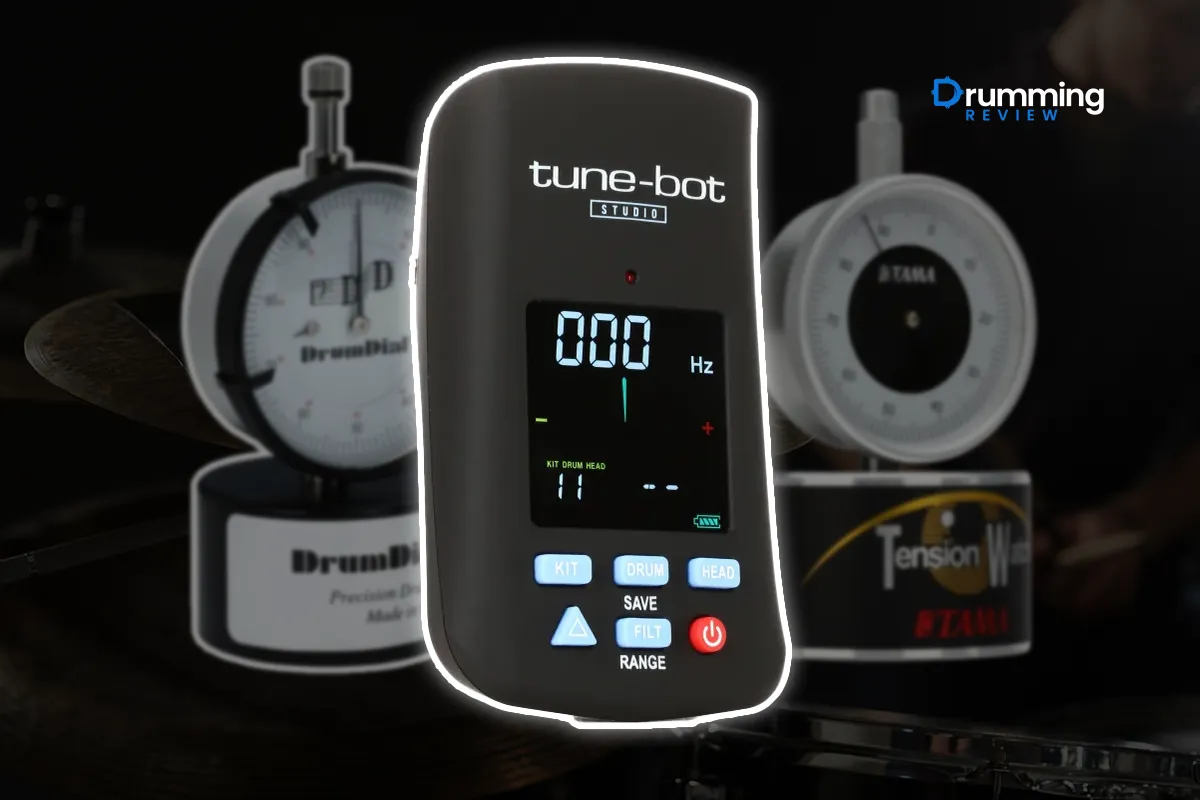
We may earn a commission from the affiliate links on this site. Learn more›
Tuning your drums can be an annoying and tedious task. For someone with little tuning experience, picking out a drum tuner might be the best solution. While some of these products claim to provide perfect results, do they really stand up to the age-old ear?
Right off the bat, I’d like to mention that tuning drums, even with a tool, is still a difficult art to master. Be prepared to spend a lot of time with your drums and be patient. If you’re having trouble with tuning, read below as I share my best tips for tuning drums at the bottom of the article.
Best Drum Tuners – A Quick Glance
- Most accurate tuning, with exhaustive documentation and examles: Tune-Bot Studio (read more)
- Best on a budget: DrumDial (read more)
- Best tuning app: DrumTune PRO (read more)
This article is for drummers of all skill levels looking to both improve their ear and the tone of their drums. Even though drum tuners are a useful tool, they also will aid in teaching your ear how to tune your drums when you don’t use them.
1) Tune-Bot Studio 9/10
Our recommendation
The Tune Bot Studio in my opinion, is the best drum tuning product available on the market. I love that gives a digital readout rather than an analog one. I highly recommend this product for those who struggle with tuning drums.
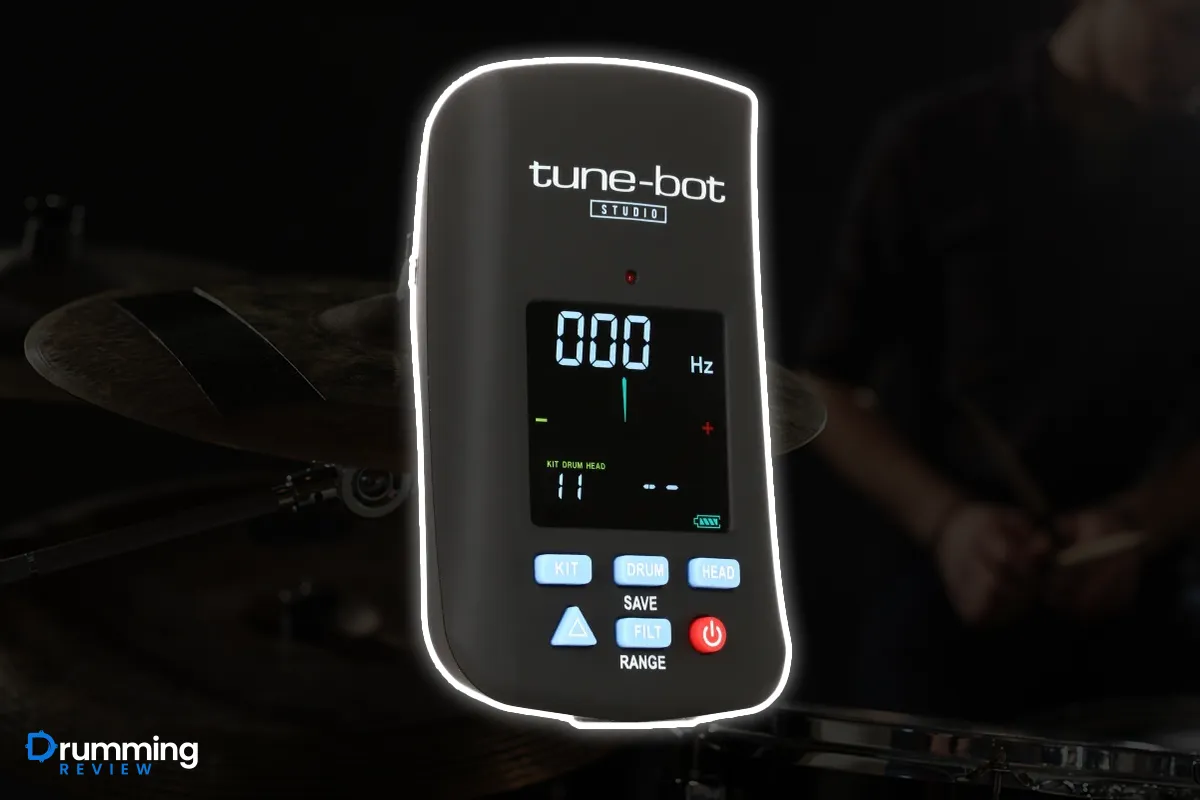
Read our full review on the Tune Bot Studio here.
The Tune Bot studio is by far the best drum tuner available. It operates more like a guitar tuner, rather than one with a mechanical dial.
It will measure the pitch of your drum as a frequency, giving you an actual note representation. Rather than placing the drum tuner on your head, this product clips on to your drum’s rim. This tuner is far more advanced than the Drum Dial in my opinion.
Tuning to Frequencies
For starters, you can tune your kit to actual musical intervals. This works great if you’re tuning your toms to the key of a certain song, which is becoming more and more popular with modern recording engineers.
It also has the ability to save and recall pitches for up to five kits with ten drums each. You actually can buy new drum heads and tune them exactly how you had them before!
No False Tuning Readings
Some drum tuners have a problem when it comes to false readings. The Tune-Bot Studio has a filter mode that avoids this issue altogether. Since it clips to you drum hoop, you’ll also be able to tune hands-free.
To use the tuner effectively, you will need patience. It’s a little tricky, as you may get a false reading. Tuning is all about patience and consistency. Be sure to hit your drum head in the exact same spot at the same velocity to get the greatest consistency when tuning.
Most poor reviews of this product focus on the inability to use the product. It seems that most users are not experienced enough to understand how to use the tuner effectively. When choosing any tuner, be sure to be patient, watch instructional videos, and be consistent.
Far Superior Support Documentation Than the Rest
Tune-Bot’s website has an exhaustive guide on how to use the Tune-Bot, with tuning settings for both the batter and resonant heads. You can pick between high, medium, and low resonant tunings. Tune-Bot has a separate documentation for snare drums, toms, and bass drums.
| Specifications | |
|---|---|
| Display | LCD Screen |
| Power Source | AAA Batteries (2) |
| Dimensions | 3.94″ x 2.36″ x 2.17″ |
| Manufacturer Part Number: | TBS-001 |
2) Drumdial 8/10
Our recommendation
Drum Dial is considered to be one of the best and oldest drum tuners on the market. I personally like the digital version, but the old analog one works great as well. My Drum Dial has been going strong for 10+ years now.

Drum Dial is one of the most popular drum tuners on the market. This is the OG tuning product. I got my first Drum Dial as a kid and have had it for ten plus years.
It’s definitely very durable and holds up over time. Drum Dials are so accurate because they measure the drum head tension and not the tension rod torque.
Drum Dial is simple to use, has a quality build, easy-to-follow directions, and takes all the guess work out of tuning your drums.
Not only can you tune acoustic drums with Drum Dial, but also timpani. Their website even has tuning charts available for reference.
How to Use Drum Dial
To use Drum Dial, first loosen up your tension rods. Finger tighten them and then place the unit on your drum, in-line with a lug, about an inch away from the rim. Make sure the drum is level to prevent Drum Dial from sliding. Then, apply pressure to the top of the dial to get a reading.
Take the number from the reading and repeat the same step all around the drum, adjusting it to the reading of the first number. Once your drum is in tune with itself, you can make adjustments to lower or raise the pitch of the drum.
Drum Dial Tuning Chart
This chart is taken from Drum Dial’s official support documentation. The numbers don’t give any clear indication of why you’d tune each size drum to certain value, but I figured we’d include it.
| Drum Size | Batter Med. Clear | Batter Coated | Batter 2-Ply | Resonant Thin Clear |
|---|---|---|---|---|
| 8 x 8 | 72-78 | 76-79 | 77-82 | 70-75 |
| 9 x 10 | 72-78 | 75-78 | 77-82 | 70-75 |
| 10 x 12 | 72-78 | 75-78 | 77-82 | 70-75 |
| 11 x 13 | 74-79 | 75-78 | 77-82 | 70-75 |
| 12 x 14 | 74-79 | 75-80 | 78-83 | 70-75 |
| 13 x 15 | 75-80 | 77-82 | 78-83 | 70-75 |
| 14 x 16 | 75-80 | 77-82 | 78-83 | 70-75 |
| 14 x 14 | 75-80 | 75-80 | 78-83 | 70-75 |
| 16 x 16 | 75-80 | 75-80 | 78-83 | 70-75 |
| 16 x 18 | 77-82 | 78-83 | 78-83 | 80-85 |
| 4 x 14 | 85-90 | 80-85 | ||
| 5 x 14 | 85-90 | 80-85 | ||
| 5.5 x 14 | 85-90 | 80-85 | ||
| 6.5 x 14 | 85-90 | 80-85 | ||
| 14 x 18 | 75-80 | 78-83 | 75-80 | 78-85 |
| 16 x 20 | 75-80 | 75-80 | 73-78 | 75-80 |
| 16 x 22 | 75-80 | 75-80 | 73-78 | 75-80 |
Other Variations of Drum Dial
Drum Dial currently makes two types of drum tuners: analog and digital. The Digital Drum Dial is a bit more expensive but does provide a more accurate reading.
Many producers use this tuner in the studio, especially when they own a studio kit. Engineers often have a particular way of tracking drums and they often like to have the drums tuned a certain way for maximum resonation in a room.
Keep this in mind if you are ever tracking at a recording studio. You may have your own personal preferences, but this may not achieve the greatest result possible.
| Specifications | |
|---|---|
| Display | Dial Gauge |
| Power Source | Passive |
| Manufacturer Part Number: | DD |
3) Tama Tension Watch 7/10
Our recommendation
Tama’s Tension Watch operates just like the Drum Dial, though not as accurate in my opinion and is much more expensive.
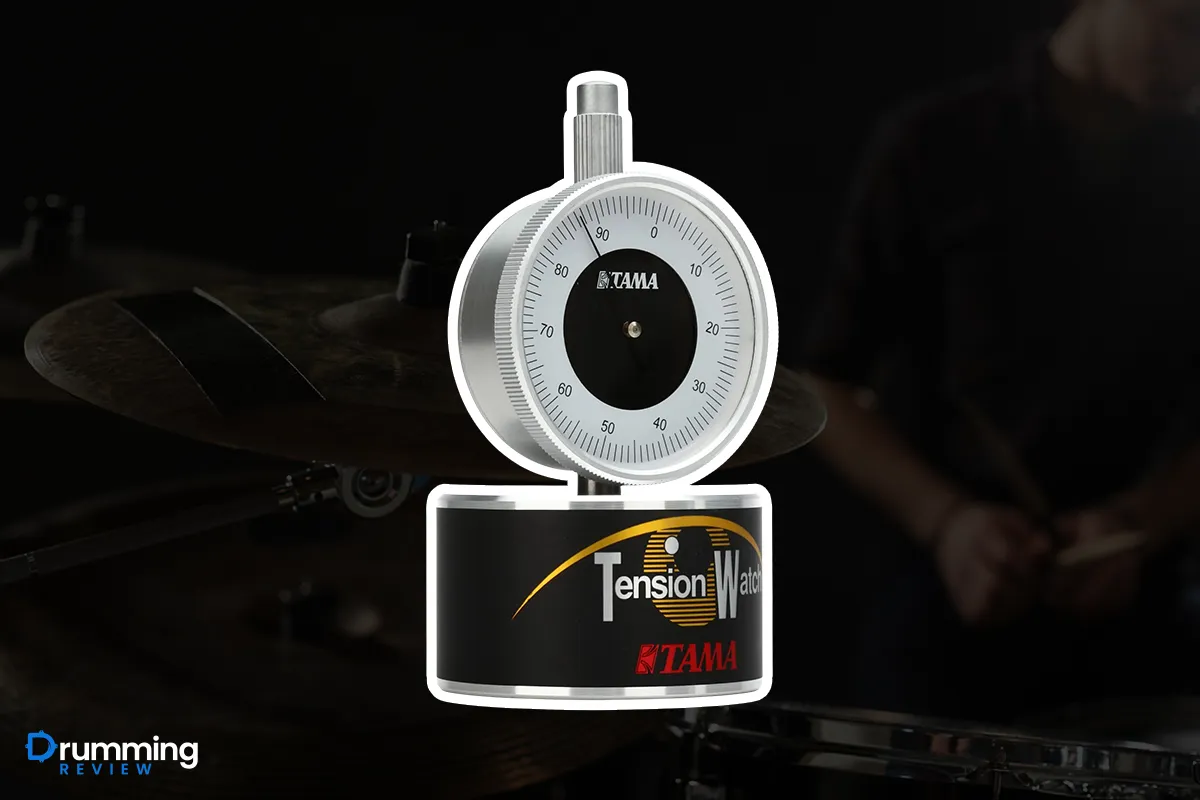
Just like the Drum Dial, the Tama Tension Watch operates in a similar fashion. I found that the Drum Dial is more accurate and produced better results every time. It’s much more user-friendly and is more consistent.
The old variant of the Tama Tension Watch resembles an old drain plug if you ask me. It features this detachable nylon bumper that ensures a consistent measuring distance from the rim. It’s a good idea in practice but looks rather strange.
Tama also makes a newer tension watch (the one in the product box above) that looks eerily similar to the Drum Dial’s design called the Tama TAMTW100.
Just like the other tension watch, this drum tuner gauges real head tension and not the tuning rod torque. Both drum tuners feature an analog display which is not as accurate as its digital counterparts. Instructions included contain sample tuning settings.
Like with DrumDial, Tama’s support documentation is very limited when it comes to tuning examples for various tones and styles.
| Specifications | |
|---|---|
| Display | Dial Gauge |
| Power Source | Passive |
| Manufacturer Part Number: | TW100 |
4) Tru Tuner Drum Head Replacement System 6/10
Our recommendation
While not a traditional drum tuner, the Tru Tuner system provides a way to easily change heads while using one of the other three tuning products to handle the finishing touches.
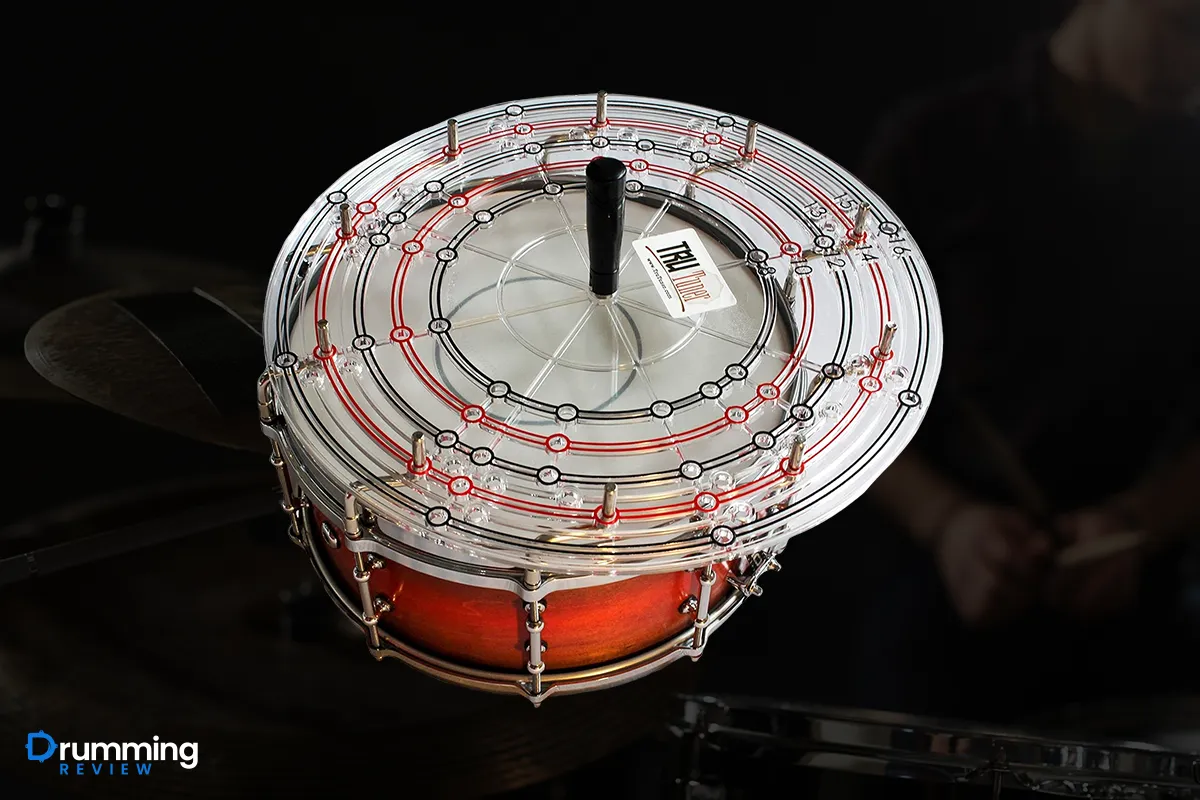
This thing is wild. From the picture alone, you can’t even imagine what you are buying. This is a bit of an outlier on our list but still deserves some recognition.
This drum tuner allows you to remove all lugs on your drum simultaneously to reduce the hassle of changing heads. You can change your snare drum head in less than a minute!
When using the Tru Tuner, you’re actually tuning all the tension rods at the same time, allowing for perfect tension at the same time. One of the big issues of tuning a drum by hand is uneven tension to the opposite lug.
For example, if you tune the closest lug to your body, the one farthest away from the opposite side will naturally detune. This drum tuner completely alleviates this problem.
While not a traditional drum tuner by any means, the Tru Tuner still makes our list as one of our favorites. It’s not a bad price to pay for how useful this product will be to you.
5) Drumtune PRO 8/10
To all the drum app lovers out there, you need not worry—we’ve got you covered. Drumtune PRO is by far, the best drum tuning application around.
Drumtune PRO is an iOS/Android application that features precise pitch detection. Who would have thought we would one day be able to tune our kit with our devices?
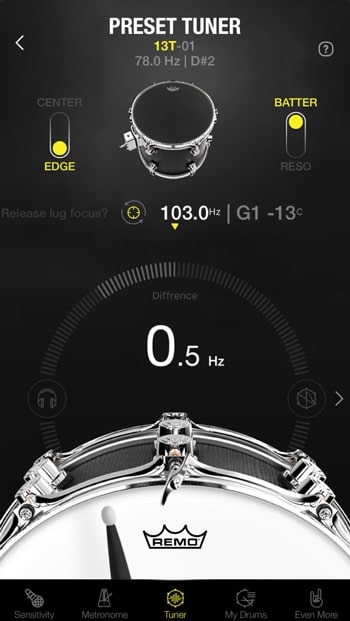
The user interface is sleek and simple to use. Drumtune PRO makes it easy to tune your kit to specific note values, allowing you to maintain a better relationship between drums.
For example, I like to have my toms tuned a minor third apart. The app detects the current pitch of a given drum, and allows me to adjust from that point.
Saving presets is no problem, either, so you’ll always be able to recreate the tuning you like. Drumtune PRO also features a built-in metronome for practicing.
What is a Drum Tuner?
A drum tuner is a tool that aids a drummer or studio engineer when tuning drums.
While many drummers opt to tune drums by ear, a tuner will give a visual representation of the tension on each lug and help an untrained ear tune a drum to sound more professional.
Drum tuners are typically used more frequently in recording studios during sessions.
Some recording engineers even swear by them and ask the drummer to utilize these types of tools rather than just their own ears.
Do You Need a Drum Tuner?
If you’ve read this far, chances are you are having trouble tuning your drums.
I don’t believe that it’s necessary to own one of these products, but they can assist you if you are struggling.
That being said, if you own your own recording studio, I highly suggest investing in one as most drummers who come in to record probably won’t bring one with.
Drum tuners are also extremely useful for touring drummers and drum technicians.
I have been in so many situations myself as a touring drummer where I’ve wanted to tune my drums, but wasn’t able to due to the ample amount of noise in the room prior to our soundcheck.
Tuning drums is impossible with another band blaring through the PA speakers.
I wouldn’t only rely on a visual representation for tuning my drums, but at least I would have a good starting point when I wasn’t able to physically listen to the tuning.
How To Change Drum Heads and Tune Drums
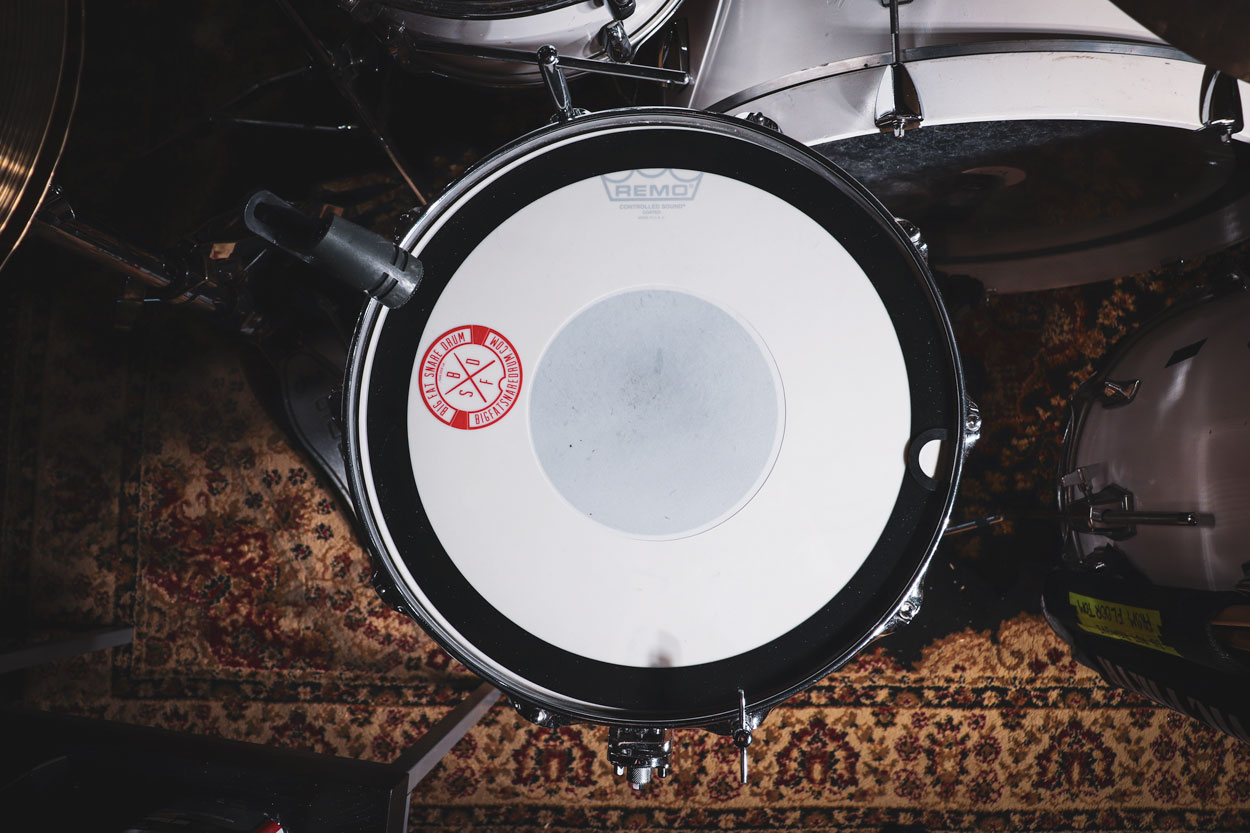
Remove Old Heads
First things first, you’ll want to remove the old drum head by loosening the tension rods around the drum with a key. Once loose, try to remember which tension rod went into each lug, as the reassembly will be smoother.
Clean Inside Of Drum And Bearing Edge
If you haven’t changed your drum heads ever, there’s likely going to be dust and dirt built up around the bearing edge of the drum and inside. Use a soft towel.
Add A Small Coat Of Paraffin Wax To The Bearing Edge (Optional)
This is something I like to do, but you can totally skip. I feel as if the new drum head sits nicer on the bearing edge with a little coat of paraffin wax. I cover this and more in my article on drum maintenance.
Apply New Drum Head To Bearing Edge
Get your new head out and seat it on the bearing edge. Once done, bring the counterhoop and tension rods back, seat it on top of the head and finger tighten the rods.
Use Drum Key To Tune
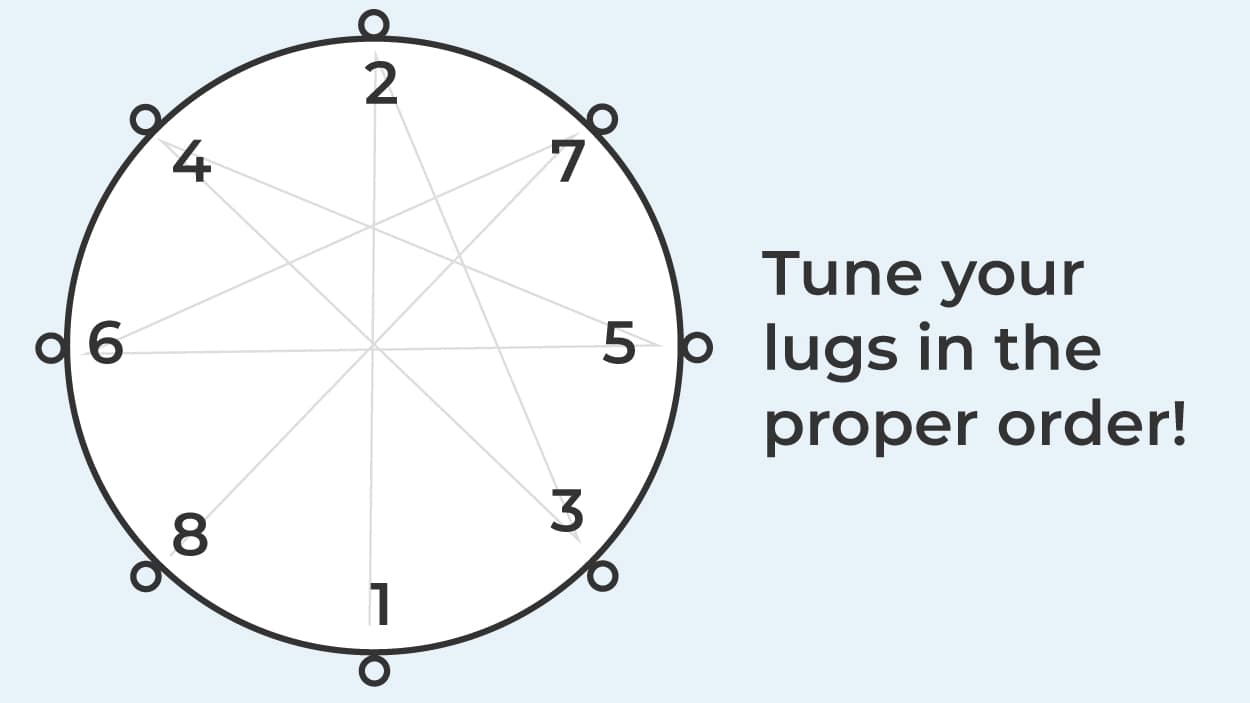
Once finger tight, use your drum key to tune the tension rods. I like to do two or so full turns for each rod on the first go around, making sure to go in an opposite order of my starting lug. Check the image below to see the order.
Tune Drum To Taste
Using your finger, place light tension on the center of the drum. While pressing, tap about an inch away from each of the lugs, listening for differences in pitch. Adjust tension accordingly until the drum sounds in tune. If you have a drum tuning device, now is the time to use it.
For more in-depth information, be sure to read my ultimate guide on how to tune a drum set!
Why Perfectly Tuned Drums May Sound Bad
While the drum tuning products listed above may help you, there may be other factors and variables that might be making your drums sound bad.
The Room Has a Big Impact
This is such an overlooked point. Bad sounding rooms have a huge impact on how great your drums will sound. For example, I may play a show one night in a club that sounds amazing, due to the acoustics of the room in relation to where I am on stage.
The toms sound huge and bright and the room itself has a natural reverberation that makes my drums sing. However, the night next on stage may sound terrible, regardless of how great my drums are tuned.
If you are playing in a poor-sounding room, there’s not much you can do about it.
Old Drum Heads are Dead
If you’ve been playing drums for a few years and you haven’t changed your drum heads yet, do yourself a favor and go grab some new ones.
While I have heard of some people out there who swear by broken in drum heads, this is not something I can get behind. Old drum heads lose their tension and begin to sound dead after being playing for a long time.
Improper Drum Head Seating
When a drum head sits on the bearing edge, it needs to be seated correctly. If not, the tension rods will apply uneven pressure when tuned and the drum may have a “papery” and thin tone when played.
When seating your new drum head, be sure to apply a little pressure on it before beginning to tune the tension rods. This will ensure that the head is in place you will achieve an even tuning.
Drum Tuning Tips and Tricks
Stretch Your Drum Heads
Upon applying and seating your new drum heads, it’s important to get them a little stretched out.
After applying some medium tension on the lugs, place your palm in the center of the head and apply some force. You may hear some cracking, but that’s just the excessive glue loosening its grip. This is perfectly normal.
Tune the Batter Head Lower
While different styles call for different tunings, in my experience, tuning the top head lower and the resonant head up higher gives me a great result every time. The toms have more power and are fatter in tone and pitch.
Use a Drum Key Drill Bit
While we did mention the Tru Tuner system, if you have a drill laying around at home, check out the drum key drill bit from Drum Workshop. I bring my cordless screw gun on tour and can’t think of what I’d do without this for changing heads in a pinch.
Experiment with Dampening
Can’t get that ring to stop? Try experimenting with different dampening: gaffers tape, Moongel, Drum Dots, dampening rings, Duct Tape (actually, don’t), towels, whatever you can think of!
Always Tune the Tension Rod Opposite
If you want to get a quicker and better result when tuning, always tune the tension rod opposite the one you’re currently on next. As you tune one tension rod, you’ll find that others around it will tend to loosen.
Tuning with this opposite technique tends to reduce this and gets your drum in tune faster.
Using Your Ear – The Best Drum Tuner is YOU
We have to remember that every product on this list is just a tool. Even after using the Drum Dial or the Tune Bot Studio, you’ll need to go back in and make fine-tuned adjustments for each drum.
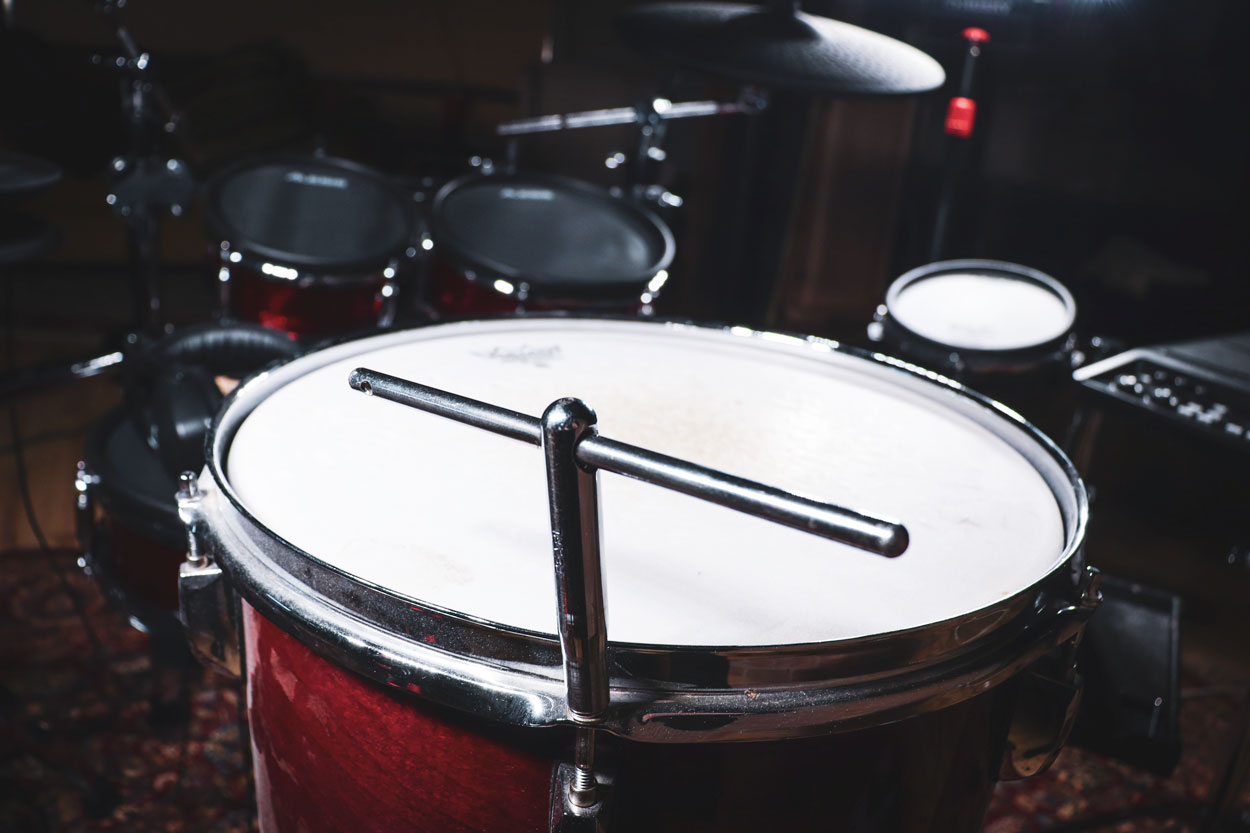
There’s no way a computerized system can predict all factors on your drums. For example, if your drum’s bearing edge is a little warped, the Drum Dial might give you a good reading, but you’ll need to make a subtle adjustment on certain tension rods.
You need to know what tensions sound good for each individual drum.
Learning how the batter head and the resonant head interact with each other is equally important! You can have both drum heads perfectly “in tune,” but fight against each other because the interval between them isn’t good.
Imagine that you lose your Drum Dial. What will you do then? The best thing to do is to use these products as tools to supplement your already good drum tuning ear.
If you are completely in the dark when it comes to tuning drums, be sure to check out the millions of YouTube videos on tuning drums. Here’s one of my favorites.
Alternatives to Drum Tuning
At NAMM 2019, a newer company debuted a drum tuning system known as the Welch Tuning System.
The new hardware technology relies on a system of pulleys to adjust the tension evenly across the head. It’s pretty cool; I assume we’ll be seeing more small companies experiment with designs like this one until the big brands catch notice.
Want to skip tuning the drums altogether?
Electronic drum sets do not require any tuning and little maintenance.
There’s more of an upfront cost, generally, but they will last and have high resale value. Have you used a drum tuning gadget before? Which one do you like the most? We would love to hear from you!

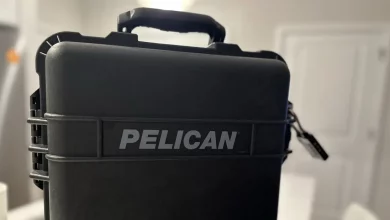

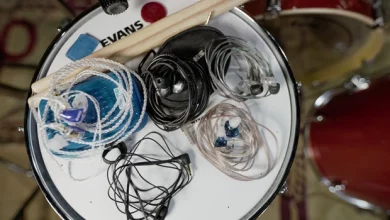
Nice article. Like you, I bought the drum dial years ago and recently bought the
tune-bot studio. It takes awhile and some practice to get the tune-bot working. I really like the fact that the instruction manual gives tuning frequency numbers for the different size drums. This way I have a clue as to what my drum should sound like.
Also, I have a vintage Gretsch kit with two 12” rack toms. With the frequency guide, I can tune one of the toms down to the “correct” frequency rather than just a lower tone than the other Tom.
I have another tool to quickly get all tension rods equally tightened. It is the RhythmTech Pro TORQ Drum Key. This thing is AWESOME! It immediately gets all rods evenly tensioned. It’s a bit tricky finding the right adjustment, but once you dial it in, (and it doesn’t take long. Only a minute or two) It’s fantastic! Using this tool and then checking it with the tune-bot is the way to go for me. Even without the tune bot you can quickly change a head and be reasonably assured that the tension is even. You just won’t know the precise frequency. The Protorq is a combination torque wrench and drum key that allows players to pre-select a tension level for tuning any drum, giving them a super fast way to tune. Boom!
0
Might be late reading this but what, I love sharing my opinion with the drumming community as it always helps to have numerous OPINIONS (not hard as stone “Facts” like some people share, usually avid Drum and Musical theorists).
I’m a +1 with Vinnie Kay, exactly…. weird haha. I owned a DDIAL for a while before recently getting the TBOT, and I can honestly swear by both. I was aware of the tune bot, but it was pricey and hard to justify buying on a budget when I already had a dial. But after a while, I really wanted to start turning to notes and frequencies, so I did some looking and found the DRUMTune Pro app on Google play. It’s funny that it wasn’t mentioned in the article considering it’s what is pictured up top, so allow me to share.
It is essentially a TBOT Studio, using your devices mic to tune to frequencies and notes, though anyone who has used both of these tuners knows that it really doesn’t compare to the TBOT studio as far as filtering and accuracy. Don’t get me wrong, it’s a great app for the price, and it does function, but its really not even close in comparison. DRUMTune Pro also comes with a bunch of handy features (save kits, interval tuning) and guides (frequency ranges, intervals, etc) which are a little bit more helpful than what comes in the tunebot manual. You can try it free for a week and subscribe for $1.99/month after that (it won’t automatically do that, which is always a plus) or buy it outright for like $20-30.
*tip* Put a moongel or tone ring on the drum while tuning, It really helps reading through the overtones
My personal opinion is save to get a TBOT studio. Make sure it’s the STUDIO, not the cheaper GIG model. I had a chance to try the gig and the filters suck, and you cant save kits for recall. Use the app I mentioned until you can afford it.
0
Aaron, thanks for the reply! So much insightful information there! Regarding the inclusion of the app shown in the featured image, I completely forgot to add in some words about it! I took the photo, updated the image, and never came back to the article. Thanks for bringing that to my attention. Have you tried any other tuning apps? I’ve only tried DRUMTune Pro, but I see there is also iDrumTuner. I’m going to pit them against each other to see which is better. I only have an iOS device, so I don’t have access to the Google Play store.
0
Hi Aaron, thanks for the mentioning. We appreciate it. BTW, please update Drumtune PRO to the latest version. (The lug pitch detection evolved a lot. If any questions about the app, you are always welcome to reach out to support. We’re happy to help! Thanks.)
0
Hello Nick, I found this article very interesting. But I have a question. I have timpani that do not have pedals, and it is a struggle to tune them. Do you know if tune-bot would work on timpani?
0
Hi Liz,
I don’t have any experience tuning timpani, even the kind with pedals. I’ve only played timpani while using pedals to adjust pitch, never actually tuned them myself (at university, our professor was skilled in this regard). I think Tune Bot would work if it would attach to the rim properly.
0
I did a little looking around, and DrumDial has timpani tuning charts, so that might be an option: https://www.drumdial.com/how-to-use/timpani-tuning-charts/
0
Thanks for your reply Nick. I did look at DrumDial, but I could not find out how to convert the pressure reading to frequency. I assume that this conversion depends on the size of the drum. For pedal timps all we need to do is to tune to the fundamental frequency. But I need to be able to tune to a specific pitch.
0